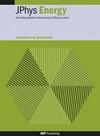Tailoring hierarchical porous core–shell SnO2@Cu upon Cu–Sn alloys through oxygen binding energy difference for high energy density lithium-ion storage
IF 6.3
3区 材料科学
Q1 ENERGY & FUELS
引用次数: 0
Abstract
Rational design and construction of self-supporting anodes with high energy density is an essential part of research in the field of lithium-ion batteries. Tin oxide (SnO2) is restricted in application as a prospective high energy density anode due to inherent low conductivity and huge volume expansion of the charge/discharge process. A new strategy that combines high energy ball milling and nonsolvent induced phase separation (NIPS) method was employed to synthesize self-supporting electrodes in which porous SnO2 was encapsulated in a three-dimensional hierarchical porous copper (Cu) shell structure (3DHPSnO2@Cu). This unique structure was constructed due to the different binding energy of the alloy with oxygen, which are −0.91 eV for Cu41Sn11 and −1.17 eV for Cu5.6Sn according to the density functional theory calculation. 3DHPSnO2@Cu electrodes exhibited excellent discharge capacity with an initial reversible capacity of 4.35 mAh cm−2 and a reversible capacity of 3.13 mAh cm−2 after 300 cycles at a current density of 1.4 mA cm−2. It is attributed that the porous Cu shell encapsulated with porous SnO2 provides buffer volume. Among them, the SnO2-Cu-SnO2 interface increases the electrical conductivity and the porous structure provides ion transport channels. This strategy opens a new pathway in the development of self-supporting electrode materials with high energy density.通过氧结合能差在铜锡合金上定制分层多孔核壳 SnO2@Cu 以实现高能量密度锂离子存储
合理设计和制造具有高能量密度的自支撑阳极是锂离子电池领域研究的重要组成部分。由于氧化锡(SnO2)固有的低电导率和充放电过程中巨大的体积膨胀,其作为高能量密度阳极的应用受到了限制。我们采用了一种结合高能球磨和非溶剂诱导相分离(NIPS)方法的新策略来合成自支撑电极,其中多孔二氧化锡被封装在三维分层多孔铜(Cu)壳结构(3DHPSnO2@Cu)中。根据密度泛函理论计算,Cu41Sn11 和 Cu5.6Sn 的结合能分别为 -0.91 eV 和 -1.17 eV。3DHPSnO2@Cu 电极表现出优异的放电能力,在电流密度为 1.4 mA cm-2 的条件下,初始可逆容量为 4.35 mAh cm-2,循环 300 次后可逆容量为 3.13 mAh cm-2。这归因于多孔锡氧化物包裹的多孔铜壳提供了缓冲容积。其中,SnO2-Cu-SnO2 界面增加了导电性,多孔结构提供了离子传输通道。这一策略为开发具有高能量密度的自支撑电极材料开辟了一条新途径。
本文章由计算机程序翻译,如有差异,请以英文原文为准。
求助全文
约1分钟内获得全文
求助全文
来源期刊

Journal of Physics-Energy
Multiple-
CiteScore
10.90
自引率
1.40%
发文量
58
期刊介绍:
The Journal of Physics-Energy is an interdisciplinary and fully open-access publication dedicated to setting the agenda for the identification and dissemination of the most exciting and significant advancements in all realms of energy-related research. Committed to the principles of open science, JPhys Energy is designed to maximize the exchange of knowledge between both established and emerging communities, thereby fostering a collaborative and inclusive environment for the advancement of energy research.
 求助内容:
求助内容: 应助结果提醒方式:
应助结果提醒方式:


